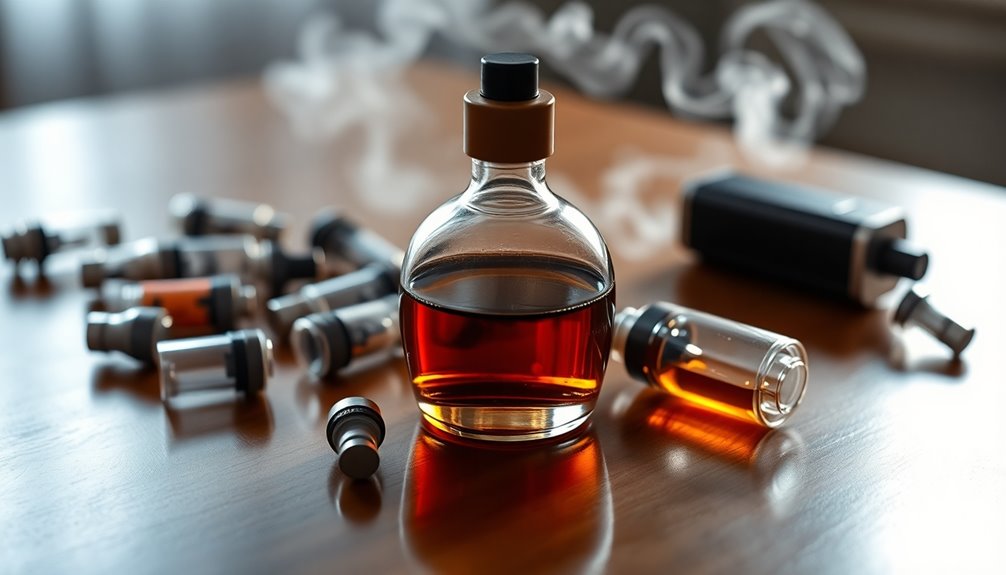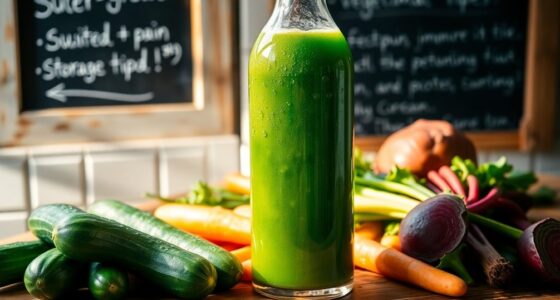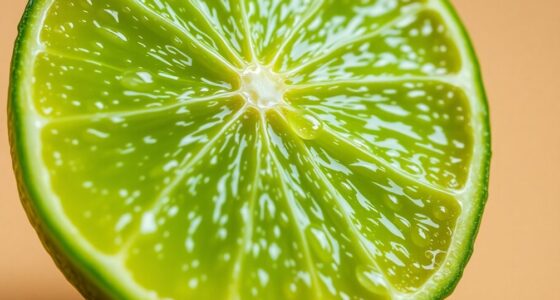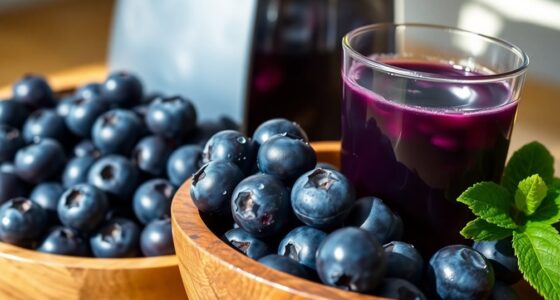A 60ml bottle of vape juice can last quite a while, but it really depends on your usage. If you're a heavy vaper using sub-ohm devices, it might only last a couple of days. For moderate vapers, it can stretch to about 10 days. Mouth-to-lung vapers usually use less, making their juice last even longer. Understanding your habits can help manage your supply better. Stick around to discover more about optimizing your vaping experience!
Key Takeaways
- Heavy vapers using sub-ohm devices can consume a 60ml bottle in about 2 days.
- Moderate vapers typically use around 6ml per day, making a 60ml bottle last approximately 10 days.
- Mouth-to-lung (MTL) users generally require less juice, extending the lifespan of a 60ml bottle even further.
- Tracking daily usage helps estimate how long a 60ml bottle will last based on personal consumption patterns.
- Nicotine levels can influence consumption rates; higher levels may lead to quicker satisfaction and reduced overall usage.
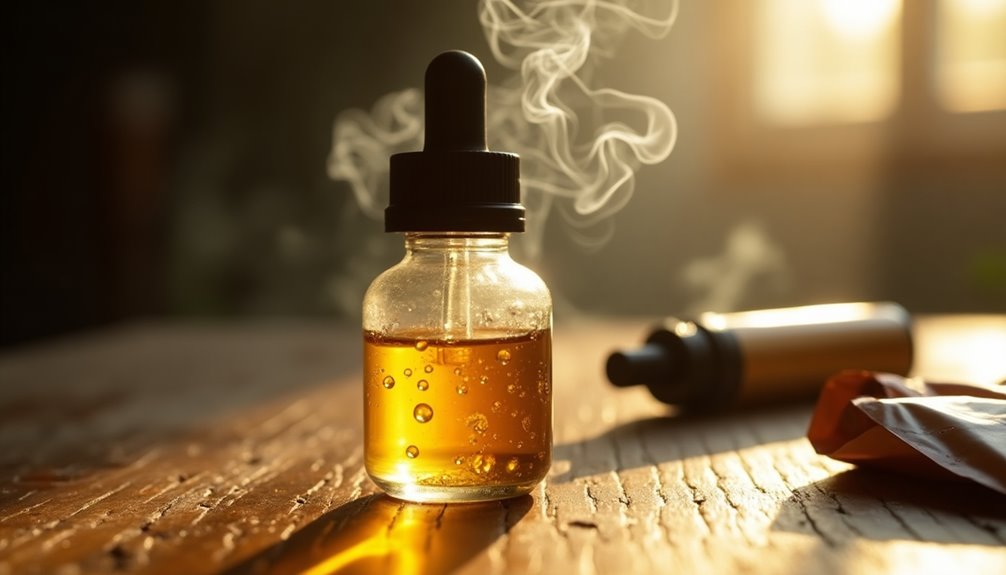
Have you ever wondered how long a 60ml bottle of vape juice will last? The answer isn't straightforward, as it largely depends on how much you vape each day. If you're a heavy vaper, especially using sub-ohm devices, you might find yourself going through that bottle in just a couple of days. These devices produce larger clouds and require more juice, leading to consumption rates that can reach up to 30ml per day. In this case, a 60ml bottle won't last long at all—perhaps only 2 days.
On the other hand, if you're a moderate vaper, your consumption might be around 6ml per day. This means a 60ml bottle could last you about 10 days. You can stretch that bottle even further if you're a mouth-to-lung (MTL) user, where the vaping style typically requires less juice. Depending on your nicotine level and personal usage, a 60ml bottle could easily last anywhere from 1 to 2 weeks.
So, how long does a bottle last really boils down to your vaping habits and preferences. To get a better idea of how long your vape juice will last, keeping track of your daily usage can be incredibly helpful. Just jot down how much you're using each day, and you'll quickly see patterns emerge. This way, you can estimate when you might need a refill.
You might also want to consider the nicotine level in your vape juice. Higher nicotine levels can satisfy cravings more quickly, potentially leading you to vape less overall. If you're trying to quit smoking, finding a balance in nicotine levels can aid your transition, making it easier to manage your consumption.
Another factor to consider is the expiration date of your vape juice. While most bottles come with a recommended shelf life, it's essential to be mindful of how long you keep your juice. If your vape juice has expired, it can affect flavor and performance. You don't want to consume expired juice, as it may not only taste bad but could potentially lead to adverse effects. Always check for any signs that your juice might be past its prime, like changes in color or separation of ingredients.
Ultimately, understanding how long your 60ml bottle of vape juice will last involves a bit of self-awareness. By knowing your vaping style and daily habits, you can make better choices about how much juice to buy at once. This will ensure you're never caught without your favorite flavor and can help you manage your vaping experience more effectively.
Frequently Asked Questions
How Long Should 60 Ml of Vape Juice Last?
When you're considering how long 60ml of vape juice should last, it really depends on your vaping habits.
If you vape moderately, it might last you around a week or so.
For lighter users, you could stretch it to two weeks.
But if you're a heavy vaper, don't be surprised if you finish it in just a few days.
Keep an eye on your usage to get a clearer picture of your consumption.
How Many Puffs Is 60ML of Vape Juice?
When you're wondering how many puffs you'll get from 60ml of vape juice, it really depends on your vaping style and device.
If you're using a sub-ohm device, you might get around 1,200 puffs, while mouth-to-lung vapers can stretch that number to about 2,400 puffs.
Keep in mind, your individual habits, like puff length and frequency, play a huge role in determining how quickly you'll go through that e-liquid.
How Many Ml Is Normal to Vape a Day?
Vaping's like sipping a favorite drink; it can vary from person to person.
On average, you might find yourself consuming about 2 to 3ml of vape juice daily. If you're a heavier user, that number can skyrocket to 10ml or more.
Remember, your vaping style matters—Direct Lung vapers usually use more compared to Mouth to Lung users.
Tracking your habits can help you find a balance that suits your preferences.
How Long Does a 30 Ml Bottle of Vape Juice Last?
A 30ml bottle of vape juice can last you anywhere from 2 to 10 days, depending on how much you vape daily. The duration a bottle lasts varies greatly among users, as each person’s vaping habits, preferences, and the device they use can significantly impact consumption rates. To better understand how long vape juice lasts, it’s essential to consider factors such as the nicotine strength, the size of the puffs taken, and the frequency of vaping throughout the day. Ultimately, keeping track of your usage will help you gauge when it’s time to restock your favorite flavors.
If you're a moderate vaper, consuming about 3 to 6ml a day, you'll likely see it last around a week.
Heavy vapers may finish it in just 1 to 3 days, while casual users can stretch it for several weeks.
Keep track of your usage to gauge how long it'll last you.
Conclusion
In the end, how long 60ml of vape juice lasts really depends on your vaping habits. If you're like my buddy Jake, who vapes all day while working, that bottle could vanish in just a week. But for the casual user, it might stretch out for a month or more. Think of it like a favorite book; some read it cover to cover in a weekend, while others savor each chapter over time. Enjoy your vape journey!
Cindy thoroughly researches juicing trends, techniques, and recipes to provide readers with practical advice and inspiration. Her writing style is accessible, engaging, and designed to make complex concepts easy to understand. Cindy’s dedication to promoting the advantages of juicing shines through her work, empowering readers to make positive changes in their lives through the simple act of juicing.

